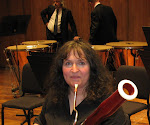A phrase marked soto voce is followed by a phrase marked un poco piu p. I spent considerable time thinking about that. It drove me crazy. "Under voiced" or "hushed" is followed by "a little more piano." WHAT does that MEAN?
Is the second phrase stronger or weaker? I have to decide; I have to prepare the 1st movement bassoon solo in Sibelius Symphony No. 5. So, unless conductor George Manahan requests otherwise, I am choosing to play it slightly stronger than the first phrase. I made the decision based upon the fact that the 3rd phrase is marked mf, and the 4th is poco meno f, followed by piu mf, then poco f and finally cresc. poco a poco al fff dim.
What we have, perhaps, is one enormous crescendo, with several hairpins along the way, followed by a brief diminuendo..
I did struggle with this conclusion. For example, poco meno f follows mf. In other words, ""a little less forte" follows "medium forte." Wow. How can I be sure that poco meno f is louder? And how on earth can I be sure that piu mf (more medium forte) should really be stronger than its preceding poco meno f (a little less forte)????
I am not at all sure. But it's a bassoon solo, and it's my job to prepare it to the best of my ability. It doesn't do much good to listen to recordings, because the dynamic range of the bassoon is so limited that these nuances are all but indiscernable.
I am reminded of the words of my teacher, K. David Van Hoesen: "I don't care how you play the music, as long as it's convincing!"
Whatever I decide about the semantics, I have to sell it to the conductor and ultimately to the audience. After my decisions are made, I practice those decisions until they are convincing. Then, when I'm feeling adequately prepared, I tape my practice sessions in order to hear my renditions from the listener's perspective. That's when I'll really know if my decisions were sound, or if changes may be in order. The taping sessions also point out issues with vibrato and note matching. It's important to be positioned far enough away from walls or large objects which may distort the sound of the bassoon. Sometimes even metal music stands create problems if they're positioned too close to the player. (In the orchestra I always shove my stand as far away as possible, much to the dismay of the oboists who sit in front of me!)
I researched this symphony to see if anything had been written about Sibelius' intentions. No luck. But I learned some interesting facts: this symphony was commissioned by the Finnish government for Sibelius' 50th birthday on December 8, 1915, which had been declared a national holiday. At the exact moment of Sibelius' demise in a nursing home in 1957, his 5th Symphony was being performed in nearby Helsinki. His 5th Symphony had given him a lot of trouble- never satisfied with it, he revised it many times after its premier. Maybe that explains the verbose yet confounding directions he left for the bassoon player......
This is The Record of John
-
Our sermon today used this passage so it was fun to land on this. Orlando
Gibbons: This is the Record of John The Gesualdo Six From the YouTube page:
The G...
7 hours ago







5 comments:
I'd go with the general direction the line seems to be heading in. Crescendo gradually until the measure after K. Not that there would be much crescendo between the first two phrases - from the audience the difference may be barely perceptible. But maybe that's what Sibelius intended.
Did that not help? Sorry... Actually, I just thought, seeing the score might help, to see if others playing at the time have the same marking, or if perhaps you got a transcribing error. LOL...
P.S. I always hated risers because I felt like I was swallowing the stand. I'd put the stand on the floor right behind the oboes amd jack it up high, and every once in awhile nail whoever was in front of me. Then they'd turn around and glare, LOL. (Stage whisper: "SORRY!!")
When they got rid of the risers it made the oboes happier... and that's not a bad thing. They could always retaliate with A=438! (Not that that would EVER happen in a professional orchestra)
Dear TAB,
Well, at least you're not too lazy to comment! I usually respond quicker, but I've been distracted.
I should have mentioned in the post that the 1st 3 phrases are in unison wit6h the 1st clarinet. I play those without vibrato, and then start using vibrato when it becomes a true solo.
I asked the conductor about it. His only concern was balance! He wants to be sure that the bassoon is heard over the strings, although he said the solo was projecting fine.
I finally decided that the best approach was to take it moment by moment, responding to the string accompaniment. I think that approach is working. Sibelius wanted the solo to be dramatic- I think if I keep that concept in mind, the result will be one he'd approve of.
Betsy
I'd love to hear this. Do you know if they'll send an email out with the link?
TAB, I think they will send an email with a link. The concert was live streamed on the internet at 8pm Saturday, and the concert should be audio streamed very soon. Maybe I'll post it on this blog. It was definitely a bassoon-heavy concert!
Betsy
Post a Comment